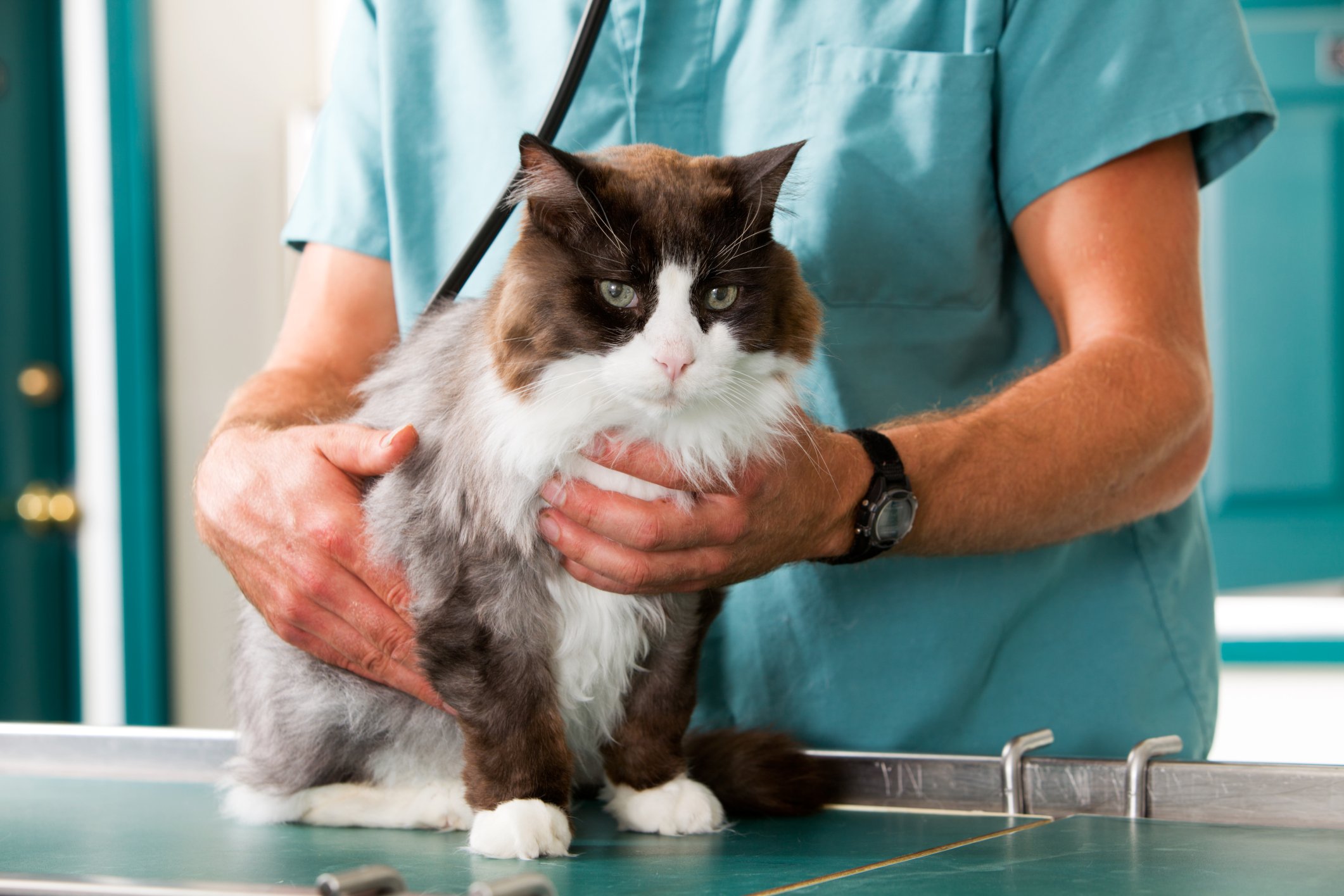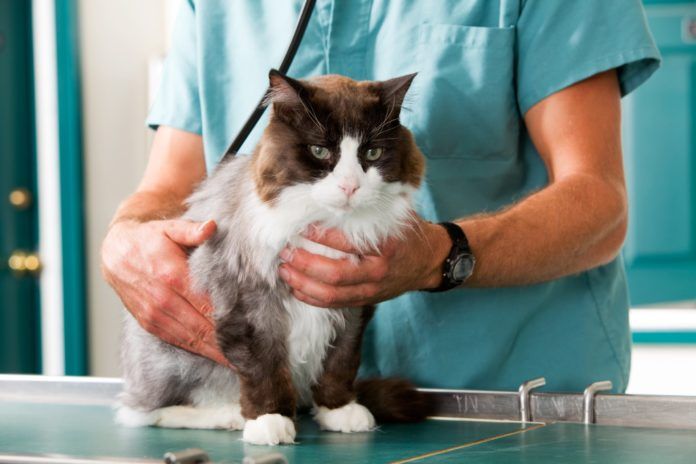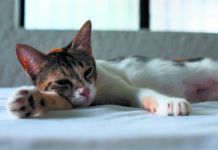The feline skeleton, comprised of nearly 250 individual bones, supports 500 or so muscles and other soft tissues that enable a cat’s movement. Among all feline musculoskeletal disorders, the most commonly observed are conditions that affect the joints — the areas in which the ends of two or more bones reside in close proximity.
Joint disorders exist in a variety of forms and can be precipitated by a wide range of factors, including genetically acquired predisposition; congenital malformation; physical trauma; immune system malfunction; and even infectious disease.
THINKSTOCK


Despite the extensive range of such diseases, says Michael Kowaleski, DVM, a professor of orthopedic surgery at the Cummings School, virtually all feline joint disorders eventually lead to osteoarthritis, a condition characterized by tissue inflammation within the joints and an eventual decline in the ability of associated bones, muscles, tendons and ligaments to function properly. And all of these disorders are exacerbated by the constant wear and tear that the joints experience during the course of a typically active cat’s daily life.
Dr. Kowaleski says the following feline joint disorders are most frequently treated at Tufts:
Hip Dysplasia. This condition is a genetically inherited malformation of the ball-and socket joint that connects a cat’s thigh bone (femur) to his pelvis. The “ball” is the smooth, spherical top end (femoral head) of the thigh bone, while the “socket” is a cup-shaped cavity (acetabulum), which is located in the pelvis. In a normal cat, the femoral head, while fitting snugly within the acetabulum, is free enough to glide and rotate, thus allowing a cat the mobility to lie down, stand up, climb trees, chase prey and so forth.
In a cat with hip dysplasia, the ball and socket are both misshapen, which prevents the femoral head from moving smoothly. In some cases, the femoral head is able to partially slide out of the acetabulum. This partial dislocation, called subluxation, causes the femoral head and the acetabulum to knock and rub against each other. Over time, this constant grinding causes the acetabulum to become shallow and the femoral head to become worn, flattened, and misshapen, resulting in looseness of the entire joint. In addition, Dr. Kowaleski notes, the constant trauma will eventually lead to osteoarthritis.
Cranial (or Anterior) Cruciate Ligament (CrCL or ACL) Rupture. This disorder affects one of the two bands of tissue that, when functioning properly, prevent the ends of the bones in the knee (femur and tibia) from sliding in a front-to-back motion.
When the front (cranial or anterior) ligament is damaged or torn, the joint surfaces slide abnormally, which will sooner or later cause severe pain and lameness. A ruptured ligament may be treated surgically, and the injured cat is likely to recover full use of an affected knee joint. However, if the ligament is not treated, a cat with a CrCL or ACL rupture is likely to put excessive weight on the unaffected leg, which may promote the development of arthritis in the knee joint of the good leg.
Meniscal Mineralization. This relatively common feline disorder is marked by the gradual buildup of hard inorganic substances, such as calcium crystals, within a cat’s two knee joints, each of which contains a rubbery, C-shaped, cartilage-like structure called the meniscus. In a normal cat, the menisci sit between the femur and tibia and provide shock absortion.
But when the tissue becomes mineralized, the menisci gradually lose their protective capability, and an affected knee joint will become increasingly dysfunctional and painful over time. In some cases, an affected meniscus may become extremely fragile and subject to tearing.
Traumatic Injury. Being hit by a car, falling out of a tree or any other trauma can result in a wide range of consequences involving a cat’s musculoskeletal system, ranging from shallow cuts and bruises to deep lacerations and broken limbs.
Although the most frequently treated traumatic injuries, according to Dr. Kowaleski, are fractures of the long bones in a cat’s front and hind limbs, an animal’s joints can be seriously injured as well. He notes that one of the most common is a fracture or luxation of the hock joint of the rear leg — that cat’s version of the human ankle joint.
Luxating Patella. This condition, Dr. Kowaleski says, is also among the more frequently diagnosed feline joint disorders. In a normal cat, the kneecap (patella) slides smoothly within a groove at the lower end of the femur to enable efficient and graceful movement.
Unfortunately, various influences — including heredity as well as traumatic injury — can cause the patella to become loose and dislocated over time. As this phenomenon progresses, the cat’s gait becomes unsteady and the animal may become lame.
Less common disorders
According to Dr. Kowaleski, other less common feline joint disorders include synovial cell sarcoma, a malignant cancer of the soft tissue that lines the surfaces within the joints; immune-mediated joint disease, an inflammatory disorder in which a cat’s hyperactive immune system attacks his own tissues, including those within the joints; and various congenital abnormalities, such as a missing bone in a limb or an absent component within a joint.
In addition, joints can develop bacterial infections. “In cats,” explains Dr. Kowaleski, “infections commonly occur as a result of bite wounds from other cats. Cats have long, pointy teeth, so if a bite occurs in a joint, the skin will heal quickly, but bacteria that have gathered within the wound have nowhere to go — and the cat can end up with a dangerous abscess in that joint.”
Diagnosis of a feline joint disorder can be a complicated undertaking. Although the clinical signs may include swollen limbs and lameness, the underlying cause may be a ligamentous, muscular, or neurologic deficit defect rather than one directly rooted in an animal’s bones or joints.
Behavior can be a clue
Moreover, Dr. Kowaleski points out, a cat’s behavior may offer few clues that something is amiss. “In most cases,” he says, “a cat will become less active than normal in order to cope with discomfort. So the real question is whether the animal is lying around in the sun all the time because she enjoys the warmth — or because her hips hurt.”
The assessment will focus initially on excluding conditions that might account for the cats discomfort. This will entail a complete medical history and overall physical examination of the patient, a thorough orthopedic exam, radiographs (X-rays) of the cat’s joints, and possible analysis of the fluids in the joints. Subsequent treatment will, of course, depend on the diagnosis.
Says Dr. Kowaleski, “A cat that has hip dysplasia can undergo surgery — possibly even a hip replacement — and can return to normal. And there can often be a surgical solution for cats that have experienced trauma, such as an ACL tear or other ligamentous injury.”
Help without surgery
In some cases, however, surgery is not an option. For a cat that has end-stage osteoarthritis and pain in an elbow or knee, joint replacement is not an available option. “In that case,” he notes, “we have to use other treatments, such as recommending that the cat lose weight and be given glucosamine, which can strengthen the cartilage in the joints.” Dr. Kowaleski says that, at present, there is no nonsteroidal anti-inflammatory drug (NSAID) that is approved for cats.
However, he notes, cats do tolerate short treatment with aspirin or a relatively new drug called Onsior, a single dose of which is said to alleviate a cat’s acute post-surgical pain for 24 hours. He warns owners, however, that cats with joint pain should never be given Tylenol, which is poisonous to them. It’s always important to discuss a medication protocol with your veterinarian. — Tom Ewing
The feline skeleton, comprised of nearly 250 individual bones, supports 500 or so muscles and other soft tissues that enable a cat’s movement. Among all feline musculoskeletal disorders, the most commonly observed are conditions that affect the joints — the areas in which the ends of two or more bones reside in close proximity.
Joint disorders exist in a variety of forms and can be precipitated by a wide range of factors, including genetically acquired predisposition; congenital malformation; physical trauma; immune system malfunction; and even infectious disease.
Despite the extensive range of such diseases, says Michael Kowaleski, DVM, a professor of orthopedic surgery at the Cummings School, virtually all feline joint disorders eventually lead to osteoarthritis, a condition characterized by tissue inflammation within the joints and an eventual decline in the ability of associated bones, muscles, tendons and ligaments to function properly. And all of these disorders are exacerbated by the constant wear and tear that the joints experience during the course of a typically active cat’s daily life.
Dr. Kowaleski says the following feline joint disorders are most frequently treated at Tufts:
Hip Dysplasia. This condition is a genetically inherited malformation of the ball-and socket joint that connects a cat’s thigh bone (femur) to his pelvis. The “ball” is the smooth, spherical top end (femoral head) of the thigh bone, while the “socket” is a cup-shaped cavity (acetabulum), which is located in the pelvis. In a normal cat, the femoral head, while fitting snugly within the acetabulum, is free enough to glide and rotate, thus allowing a cat the mobility to lie down, stand up, climb trees, chase prey and so forth.
In a cat with hip dysplasia, the ball and socket are both misshapen, which prevents the femoral head from moving smoothly. In some cases, the femoral head is able to partially slide out of the acetabulum. This partial dislocation, called subluxation, causes the femoral head and the acetabulum to knock and rub against each other. Over time, this constant grinding causes the acetabulum to become shallow and the femoral head to become worn, flattened, and misshapen, resulting in looseness of the entire joint. In addition, Dr. Kowaleski notes, the constant trauma will eventually lead to osteoarthritis.
Cranial (or Anterior) Cruciate Ligament (CrCL or ACL) Rupture. This disorder affects one of the two bands of tissue that, when functioning properly, prevent the ends of the bones in the knee (femur and tibia) from sliding in a front-to-back motion.
When the front (cranial or anterior) ligament is damaged or torn, the joint surfaces slide abnormally, which will sooner or later cause severe pain and lameness. A ruptured ligament may be treated surgically, and the injured cat is likely to recover full use of an affected knee joint. However, if the ligament is not treated, a cat with a CrCL or ACL rupture is likely to put excessive weight on the unaffected leg, which may promote the development of arthritis in the knee joint of the good leg.
Meniscal Mineralization. This relatively common feline disorder is marked by the gradual buildup of hard inorganic substances, such as calcium crystals, within a cat’s two knee joints, each of which contains a rubbery, C-shaped, cartilage-like structure called the meniscus. In a normal cat, the menisci sit between the femur and tibia and provide shock absortion.
But when the tissue becomes mineralized, the menisci gradually lose their protective capability, and an affected knee joint will become increasingly dysfunctional and painful over time. In some cases, an affected meniscus may become extremely fragile and subject to tearing.
Traumatic Injury. Being hit by a car, falling out of a tree or any other trauma can result in a wide range of consequences involving a cat’s musculoskeletal system, ranging from shallow cuts and bruises to deep lacerations and broken limbs.
Although the most frequently treated traumatic injuries, according to Dr. Kowaleski, are fractures of the long bones in a cat’s front and hind limbs, an animal’s joints can be seriously injured as well. He notes that one of the most common is a fracture or luxation of the hock joint of the rear leg — that cat’s version of the human ankle joint.
Luxating Patella. This condition, Dr. Kowaleski says, is also among the more frequently diagnosed feline joint disorders. In a normal cat, the kneecap (patella) slides smoothly within a groove at the lower end of the femur to enable efficient and graceful movement.
Unfortunately, various influences — including heredity as well as traumatic injury — can cause the patella to become loose and dislocated over time. As this phenomenon progresses, the cat’s gait becomes unsteady and the animal may become lame.
Less common disorders
According to Dr. Kowaleski, other less common feline joint disorders include synovial cell sarcoma, a malignant cancer of the soft tissue that lines the surfaces within the joints; immune-mediated joint disease, an inflammatory disorder in which a cat’s hyperactive immune system attacks his own tissues, including those within the joints; and various congenital abnormalities, such as a missing bone in a limb or an absent component within a joint.
In addition, joints can develop bacterial infections. “In cats,” explains Dr. Kowaleski, “infections commonly occur as a result of bite wounds from other cats. Cats have long, pointy teeth, so if a bite occurs in a joint, the skin will heal quickly, but bacteria that have gathered within the wound have nowhere to go — and the cat can end up with a dangerous abscess in that joint.”
Diagnosis of a feline joint disorder can be a complicated undertaking. Although the clinical signs may include swollen limbs and lameness, the underlying cause may be a ligamentous, muscular, or neurologic deficit defect rather than one directly rooted in an animal’s bones or joints.
Behavior can be a clue
Moreover, Dr. Kowaleski points out, a cat’s behavior may offer few clues that something is amiss. “In most cases,” he says, “a cat will become less active than normal in order to cope with discomfort. So the real question is whether the animal is lying around in the sun all the time because she enjoys the warmth — or because her hips hurt.”
The assessment will focus initially on excluding conditions that might account for the cats discomfort. This will entail a complete medical history and overall physical examination of the patient, a thorough orthopedic exam, radiographs (X-rays) of the cat’s joints, and possible analysis of the fluids in the joints. Subsequent treatment will, of course, depend on the diagnosis.
Says Dr. Kowaleski, “A cat that has hip dysplasia can undergo surgery — possibly even a hip replacement — and can return to normal. And there can often be a surgical solution for cats that have experienced trauma, such as an ACL tear or other ligamentous injury.”
Help without surgery
In some cases, however, surgery is not an option. For a cat that has end-stage osteoarthritis and pain in an elbow or knee, joint replacement is not an available option. “In that case,” he notes, “we have to use other treatments, such as recommending that the cat lose weight and be given glucosamine, which can strengthen the cartilage in the joints.” Dr. Kowaleski says that, at present, there is no nonsteroidal anti-inflammatory drug (NSAID) that is approved for cats.
However, he notes, cats do tolerate short treatment with aspirin or a relatively new drug called Onsior, a single dose of which is said to alleviate a cat’s acute post-surgical pain for 24 hours. He warns owners, however, that cats with joint pain should never be given Tylenol, which is poisonous to them. It’s always important to discuss a medication protocol with your veterinarian. — Tom Ewing ation protocol with your veterinarian. — Tom Ewing




